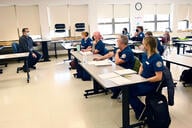You have /5 articles left.
Sign up for a free account or log in.

Student demand for online classes has risen dramatically, but many community colleges are struggling to keep up.
Drazen_/E+/Getty Images
As the dean of online learning at Portland Community College, it’s hard for Heather Guevara to overstate her college’s reliance on technology, especially post-pandemic.
Professors at the Oregon institution and at other community colleges across the country are no longer simply lecturing in their courses. They’re now incorporating videos and expecting students to engage in online discussion. Students are also accessing online courses while on campus, along with email and online learning portals.
As a result, Portland Community College, despite having fewer students on campus than it used to, is hurting from the pressure to keep students connected, with many faculty and students struggling to access Wi-Fi on campus.
“Students are depending on campuses to have reliable Wi-Fi and access to the technology they need to manage their personal lives,” Guevara said. “It’s, ‘I’ll submit that thing for the DMV,’ or ‘I’ll look at financial aid status.’ They don’t come to school and stop being a parent and employee.
“The irony is we don’t have as many students on campus, but the single student user need is greater.”
Since the COVID-19 pandemic abruptly shifted students to remote education, student demand for online courses and programs has skyrocketed, especially at community colleges.
But ramping up online education at breakneck speed, and now adopting the necessary technology to sustain these offerings long-term and at high standards, is no small feat for often cash-strapped and understaffed institutions recovering from steep pandemic enrollment declines.
Successes and Struggles
Russell Poulin, vice president for technology-enhanced education at the Western Interstate Commission for Higher Education (WICHE), said colleges expected students to stream back to campuses after the pandemic and were “caught a little flat-footed” when that wasn’t the case.
“Most of them had infrastructure for faculty development, instructional design, all this, for the amount of courses and programs that they were teaching online. Now it grew, sort of in an unplanned way, and they’re struggling to catch up with that,” said Poulin, who is also executive director of the WICHE Cooperative for Educational Technologies (WCET).
While plenty of research has been conducted on the usage of technology in higher ed, it has rarely differentiated between two- and four-year institutions, according to Jeff Seaman, director of Bayview Analytics, a statistical research firm. He noted that researchers scrambled to monitor the change in higher ed generally after the pandemic.
“There was so much change with declining enrollment, the need to revamp programs, that the ability to take a step back and say, ‘How is it different across subsets?’ makes it much more difficult to do that research,” he said.
Despite the lacking data, technology adoption is becoming more of a when than an if, according to Seaman.
| Four or more years | At least two but fewer than four years | |
| Classroom polls/clickers | 12.8% | 6.7% |
| Digital collaboration tools | 16.6% | 21.8% |
| Digital proctoring tools | 6.9% | 14.3% |
| LMS course cartridges | 14.6% | 30.5% |
| Online/digital labs | 8.4% | 9.7% |
| Phone or mobile applications | 7.5% | 10.3% |
At Northern Virginia Community College (NOVA), the majority of students are now taking online courses.
The college, which has offered distance learning for 40 years, was well positioned to take on the “extreme” growth in online learning, said Cynthia Pascal, associate vice president of e-learning at NOVA. A full 67.6 percent took an online course in the 2022–23 academic year.
Pascal said NOVA has been partnering with other community colleges in Virginia to help them build up their online offerings. The college also offers Shared Services Distance Learning, which allows students at other community colleges to take online classes at NOVA for credit at their home institutions.
“It’s not that the other institutions aren’t experts. It’s that they’re underresourced, especially when you think about our rural community colleges,” Pascal said. She finds that institutions have big dreams but limited budgets and staffing and are also challenged by “getting faculty to the same level of quality and confidence” online.
The college ramped up professional development for instructors and has systems in place to identify “orange or red flags”—signs that a student is struggling in an online course and needs academic advisers to intervene. That requires “strong technology.”
“These are students who are often parents, they’re often caretakers. They’re often working not one, but two, sometimes three jobs,” Pascal said. “So while our courses can be wonderful, if we don’t have the support resources in place … they’re going to continue to struggle.”
Some states, including California, are using shared systems to ensure all faculty members have the same confidence level.
The California Community Colleges system put all 116 institutions on one shared learning management system, and 55 institutions are in a cross-enrollment program, allowing students to take online courses at any of the participating institutions across the state. The push is the result of an initiative started more than a decade ago focused on online education.
“There isn’t a long process of planning, research, design, then get it approved. It’s, ‘Let’s see what sticks, because they need us now,’” said Marina Aminy, director of California Virtual Campus, a statewide initiative focused on college completion. “We have the neediest students with the highest risk to drop out; let’s see what works for them.”
State funding for the system is based on a formula that includes student enrollment and completion rates. California is not the only state with a cross-enrollment focus—Idaho, Montana and the University of Maryland have similar initiatives, according to Aminy.
“The idea you have a home college is super dated, and the student-centric idea is a seamless boundary of opening up the walls to include more options to let them decide.”
The technology implementation could help with declines in enrollment, which are expected to continue over the next decade as the number of traditional-age students dwindles nationwide.
Fewer students means offering fewer courses in all modalities, meaning a majority of students will have to take at least one course online because it is no longer offered in person. That reliance on virtual courses creates a strain on campus infrastructure.
“They may have to go to the library, put on a headset and participate in a Zoom class; the Wi-Fi need is so much greater than walking to their next class,” Guevara said. She noted that many campus resources, such as financial aid and admissions departments, also have virtual offices—further straining the infrastructure.
“Technology adoption is hard to do, especially when you’re underfunded,” said Hoori Kalamkarian, senior research associate at the Community College Research Center at Columbia University’s Teachers College. “It takes a lot of training time, staff time, getting a buy-in among the staff—and doing that at a community college is especially challenging.”
Costly Roadblocks
Jee Hang Lee, president and CEO of the Association of Community College Trustees, said state policymakers sometimes incorrectly assume that increasing online education saves community colleges money by lowering the costs of maintaining physical campuses.
He emphasized that campus facilities still have to be open for the students who use them, which comes with all the usual costs. Plus, online education has its own expenses, such as the need for heightened cybersecurity at a time when ransomware attacks have become increasingly common.
Poulin noted that WCET staff members met with a small focus group of six students, half of them attending community colleges, who complained about not knowing what modalities certain courses would be taught in or what technologies those courses would require at the time of registration.
“We had one student who said that she just had to drop the class because she couldn’t afford the extra technology,” he said. Clear institutional policies and communication around online education are key “to make sure that they’re serving students well.”
Theresa Umscheid, executive director of the Iowa Community College Online Consortium, a network of six colleges that share online courses, said as online enrollments grow, some of the colleges have had to get creative about how to use buildings that are now underused. For example, Iowa Lakes Community College now uses its extra building space for on-campus career and technical education classes for high school students.
Colleges have also had trouble filling some of their in-person courses, to the chagrin of some faculty members who prefer to teach on campus. The consortium dates back to 1999 and already had robust online infrastructure and faculty development in place. But it can still be a challenge “training a reluctant audience,” Umscheid said.
Community colleges also face roadblocks in adopting the technology they need due in part to the high number of adjunct professors employed by the colleges. As contingent faculty members, these workers often do not have authority to change the course curriculum. They also sometimes work at more than one college, with different technology systems.
Procurement can also be problematic for community colleges, according to James Wiley at ListEdTech, an education-focused market research firm.
“Pricing might be out of their league and they can’t get a pooled or shared contract, since a lot of vendors do not specialize or target community colleges,” said Wiley, a vice president of product and research. “And it becomes really difficult to justify the cost of such a big-ticket item at a community college.”
Lee said students’ academic outcomes are at stake if colleges don’t scale up their online classes in a way that ensures their quality.
The key question, he said, becomes “How do we create a structure that supports the students? … How do we do online advising, counseling, all these components in this structure that has traditionally been more face-to-face for our students?”
Technology Usage and Potential
Kalamkarian, of the Community College Research Center, said having the technology itself is not sufficient.
“It’s, ‘Do you have a vision? How are you going to use it? How will the student experience improve?’ Then you can get the staff onboard in terms of designing and using it.”
Kalamkarian believes communication platforms are the most popular technological tool among community colleges, which allow staff to target messages toward specific student populations. There are also data dashboards to help advisers and support staff to better view their caseloads and the overall student population, and advising technologies, which can help identify students who need more support and prevent dropouts.
Artificial intelligence, an increasingly pervasive technology on college campuses, also raises some concerns for two-year colleges, including fear of plagiarism and the loss of critical thinking skills, worries that are also evident at four-year institutions. Students tend to use this new technology more than faculty members and administrators.
“They’re turning a blind eye, or incorporating it, but a majority are clueless about what’s happening,” Aminy said of faculty members and administrators. “I think it’s going to be an entire other can of worms to impact technology in new ways.”
Wiley said AI could be transformative for community colleges: used for managing students’ transfer transcripts and tracking learning outcomes to help “set them up for success” and create a path for smoother transfers to four-year institutions.
“That’s the holy grail,” Wiley said. “And you’ll see more of that and a lot of excitement in that world.”
Looking Ahead
Aminy hopes online education improves as it grows.
“But there has to be a concentrated effort and funding to continue to support it,” she said.
Wiley believes that, unlike some four-year institutions that are fully diving into technology, community colleges will move at a slower pace.
“We are going to see them invest more, but it’ll be slow and very intentional,” Wiley said. “It won’t be this is a shiny new object. It’s, ‘Let’s be very careful to see if this is suitable for us and [will] further our goals.’”
Lee said that transition is imperative.
“The days of yesteryear, where the vast majority of students were largely within your brick and mortar, especially for your core academic programs, is long gone,” he said. “And colleges have to really be prepared.”






